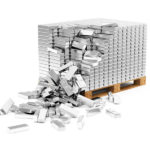Why Germany Is Going to War with Gold

(January 26, 2020 - Tyler Durden)
Owning gold is a way to get out of this “debt trap”, but governments don’t want you to own gold, especially in Germany.
Germans, like Indians and Chinese, love their gold - although their reasons for buying and keeping bullion are somewhat different.
In China and India, gold jewelry is a status symbol - a sign of wealth and success. In Germany, owning gold bars and coins, maybe a 24-karat necklace or two, is a means of preserving wealth, especially in times of war or economic crisis, something never far from Germans’ minds, considering their history.
Indeed the “war guilt” Germans experience over the atrocities of Nazi Germany is accompanied by fears that their government could again lose control of fiat money, as the Weimar Republic did in the 1920s, leading to devastating hyper-inflation.
In India “a marriage is not a marriage without gold.” Indians find it auspicious to be-gift gold jewelry during the Diwali festival, which begins in October, and wedding season. Gold-shopping for the bride is thought to bring good fortune and invoke the blessings of a Hindu goddess. At nearly 20 million weddings a year, Indians’ annual demand for the precious metal exceeds 514 tonnes. Easy to see why the country’s private gold holdings are the largest in the world, a mind-boggling 24,000 tonnes. (almost as much as the world’s top 10 central bank holdings combined)
However in 2016 China overtook India as the world’s top buyer of gold jewelry. The country’s growing throng of affluent consumers is driving demand for gold rings, bracelets and necklaces, especially in January and February when many Chinese purchase gold jewelry as gifts for Chinese New Year. According to McKinsey & Company, by 2025 China will represent up to 44% of the global luxury jewelry market.
While the populations of China and India are known for liking physical gold, Germany flies under the radar. An astounding +26 million Germans have investments in gold bars and coins. In fact far more Germans have savings in physical gold than in the stock market - a statistic hard to imagine in the United States or Canada.
According to a recent survey by the Research Center for Financial Services on behalf of Reisebank, Germans currently own 8,918 tonnes of gold worth 330 billion euros (USD$367.5 billion), just over half (55% or 4,925 tonnes) in bars and coins.
Gold fans may also be surprised to know that Germany’s central bank is loaded up with more bullion than any other’s, except for the United States, 3,366.8 tonnes versus 8,133.5t held by the US Treasury, most of which is in Fort Knox, Kentucky.
A four-year plan to repatriate 674 tonnes of German gold held at the Banque de France and the Federal Reserve of New York was completed in 2017.
Yet these facts and figures indicating strong gold buy-in are incongruous with a new German law that severely limits the anonymity of citizens’ gold purchases. In this article we are asking, “Why are Germans lining up for gold?”
“Tafelgeschäfte”
Until January 1, 2020, the maximum amount of gold an individual could purchase in Germany, without disclosing personal information, was €10,000. However in response to a European Union directive targeted at money laundering and terrorist financing, the German government set a new, far lower limit of €2,000.
The wholly predictable result? Panic gold buying, with long lines of customers queuing up outside the country’s precious metals shops and gold dealer showrooms, during the last days of December.
“We are currently being overrun,” Börse Online, Germany’s leading investor magazine, quoted the managing director at Degussa Edelmetalle, one of Germany’s biggest gold dealers, regarding the situation. “The queues go up into the street.” The other large trader, Pro Aurum, reported a tripling of normal order volumes.
The legion of gold buyers, of course, were there to purchase under €10,000 worth of gold, in anonymous transactions that don’t require identity checks, before the new rule kicked in on Jan. 1, 2020. Their rightly justified fear was that passing on one’s information to the seller, then on to the government, would allow the government to, if it wished, confiscate their gold, as has been done several times historically, detailed further down in the article.
There are a few interesting points to make about this legislation.
The first is, why did they even bother to include precious metals? The fifth EU Money Laundering Directive, introduced by the EU in 2018, set out new requirements to prevent money from being laundered and used to finance terrorist groups. A laudable goal, it was directed at over-the-counter transactions known in German as “Tafelgeschäfte”, where the customer purchases an investment or security in physical form, such as bearer bonds, an equity security with attached dividend coupons, or precious metals bars and coins.
EU member states are given flexibility in how they implement EU directives. Yet despite the directive not saying anything about precious metals, in November 2019 the German parliament, the Bundestag, passed a law that lowered the threshold where precious metals can be bought without identify checks (aka anonymous transactions) from €10,000 to €2,000. This now includes purchases of the popular 1-oz gold coin.
A second point concerns the timing of the legislation. Just three years ago, in 2017, the Bundestag changed the threshold from €15,000 to €10,000 - suggesting the German government is moving very rapidly to increase the transparency of gold transactions.
The last point is the most interesting: Why? According to the 2019 bill,
“The findings of the national risk analysis have shown that, especially in the area of gold trading, heavy cash transactions are taking place just below the current threshold for identification obligations of 10,000 euros… The threshold of EUR 2,000 envisaged in the draft law aims to prevent or significantly limit this bypass trade.”
The problem here is that, when questioned by German parliamentary deputies about the law and asked to provide evidence for it, the government either claimed to have no knowledge, or deferred responsibility to the Länder (provinces).
For example, it could not say what is the annual volume of precious metals trading in Germany, how many people living in Germany bought precious metals using anonymous cash transactions, or what was the annual volume of cash transactions for precious metals.
The question that really exposed the government’s lie - that it is targeting precious metals for money laundering - was “In how many reporting or criminal cases was there a reference to precious metals?
Data recorded by the Central Office for Financial Transaction Investigations (FIU) found that of 137,097 suspicious transactions reported to the FIU, only 239 cases related to precious metals - ie. 0.17%! And of these 239 cases, only four involved amounts below the €10,000 threshold.
The upshot? There is no evidence that over-the-counter cash purchases of precious metals have anything to do with money laundering in Germany.
So why would the government lie? There must be some other reason to target small gold purchases - ridiculously, even buying a 1-oz gold coin in Germany will now trigger an identity check. Bullion dealers are required to keep a record of all transactions over €2,000, for five years, and must by law surrender them if asked to by the authorities.
While we cannot know the answer, we have a few theories:
- The government thinks the German economy is in trouble due to excessive savings.
- The government is creating an information base for later gold confiscation.
- The government doesn’t want its citizens to own gold because their financial/ personal information can’t be easily tracked.
Taking each in turn, we find Germany’s central bank taking extreme measures to kickstart economic growth which slumped to a six-year low in 2019. The anemic 0.6% growth rate was due to a number of factors including a slowdown in its normally booming auto sector. Car production last year fell to its lowest in nearly a quarter century; layoffs have occurred. The country’s economy expanded at the slowest rate since 2013, the height of the eurozone’s debt crisis, dragged down by a manufacturing contraction of 3.6%.
Negative interest rates were introduced to provide an incentive for financial institutions to lend more money, but the tactic hasn’t worked. Economists expect growth this year to barely budge.
“The next decade will be a decade of underperformance, and people may once again start talking about Germany as the sick man of Europe,” the Wall Street Journal quotes Joerg Kraemer, chief economist at Commerzbank in Frankfurt.
One of the biggest problems is consumer spending, or to be more precise, the lack of. In the United States, Canada and other developed nations, close to zero and negative interest rates have fueled consumer and business spending, along with investment in the stock market. Not so in Germany, where citizens have shunned growth-bearing assets like real estate and stocks, preferring to sock their savings away in deposit accounts (and gold).
According to the OECD, Germans save 11% of their disposable income compared with less than 7% in the US. Another article in the Wall Street Journal states:
Last year, German households added €108.7 billion to their bank accounts, more than any time since the euro was introduced, according to Deutsche Bank research. Cash and bank deposits, at €2.5 trillion, make up 40% of Germans’ financial assets, according to Bundesbank data.
And while saving for a rainy day sounds prudent, it’s not making Germans any richer. With a median household income of €61,000 (USD$67,000), Germans are the least likely of all European to own their own homes.
In November consumer sentiment in Europe’s largest economy fell to the lowest level since November 2016, as Chancellor Chancellor Angela Merkel’s coalition of conservatives and Social Democrats (SPD) resists calls for a stimulus package to kickstart the largest economy in Europe.
Could this ingrained mindset of low spending and high savings among Germans be influencing the government’s latest foray into regulating precious metals trading? It certainly appears likely. If gold and silver buyers are made to offer up their personal information when making a bullion/ jewelry purchase, they might, instead of saving euros, consider spending that disposable income, which would help the ailing economy.
The second rationale for the rule change might be that the German government wants to make it easier to track people’s gold purchases in case they need/ want it. There are several historical instances of this happening, including in Germany. In 1939, $97 million worth of gold belonging to Czechoslovakia was stolen by Nazi Germany when its army invaded Prague.
On April 5, 1933, President Franklin Roosevelt signed an executive order criminalizing the possession of gold. Americans were required to deliver their gold bars, coins and certificates to the Federal Reserve in exchange for $20 per ounce. The limitation on gold ownership wasn’t repealed until 1974 by President Gerald Ford.
Other countries have appealed to their populace in times of crisis, to give their gold to the government. In 1935, when Italy was mired in recession, Benito Mussolini passed the “Gold for the Fatherland” initiative. Some 35 tonnes of jewelry and coins was collected then melted down, turned into gold bars, then distributed to national banks. Those who donated were given a steel wristband that read “Gold for the Fatherland”.
In 1997 during the Asian financial crisis, South Korea asked citizens to donate gold to help pay back a $58 million bailout package from the IMF. Appealing to South Koreans’ national pride and sense of shame for accepting a foreign bailout, nearly 3.5 million people, almost a quarter of the population, donated 226 tonnes valued at $2.2 billion. People’s gold necklaces, coins, bars, trinkets, statuettes, medals, pendants and military insignias were promptly melted into gold bars that helped pay off the IMF loan in 2001, three years ahead of schedule.
Our third theory on why Germany wants to limit gold ownership through lowering the anonymous transaction threshold is a little conspiratorial, but nothing we’re about to share is untrue. It can all be fact-checked, and we invite you to do so.
Since the 1970s and ‘80s, the banking system has become reliant on debit and credit cards. Many years ago I wrote an article titled ‘Ignorance is a Temporary Condition’ that explained how the switch from cash to credit has resulted in over-spending and high levels of consumer indebtedness. While the figures in the article are dated, its salient points still ring true, and bear repeating:
In the early 1970s, a nationwide electronic funds transfer system was envisioned. The system would use individualized electronic identification cards and digitized bank accounts with merchants connected to them by telecommunication links.
But it wasn’t until the 1990s that credit and debit card use really caught fire.
Is going cashless a good thing? Not for most people, we tend to spend more when we buy things with a credit or debit card instead of cash.






